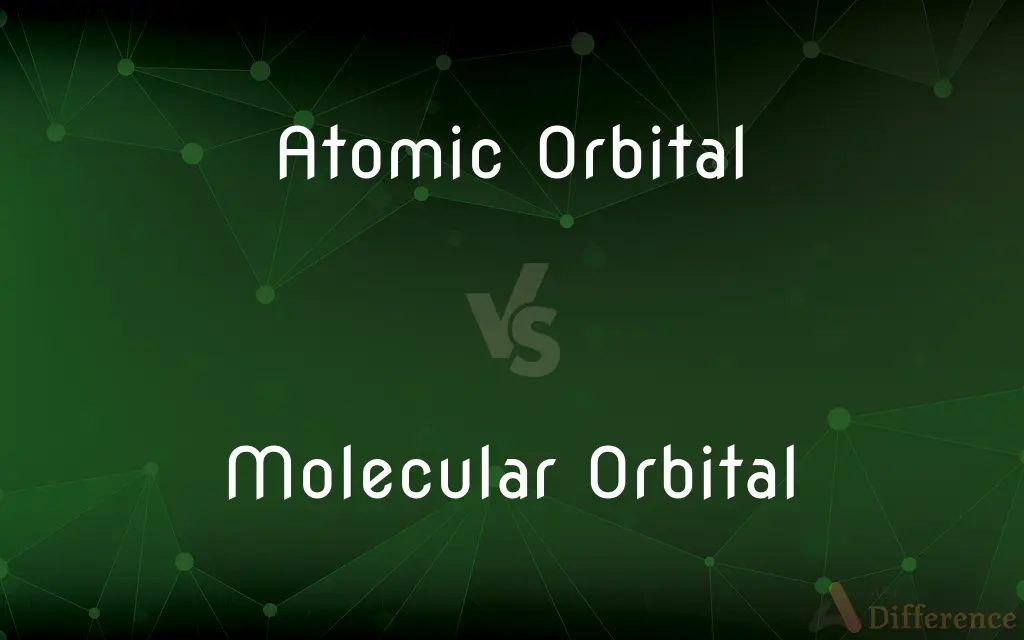Atomic Orbital vs. Molecular Orbital — What's the Difference?
By Tayyaba Rehman — Published on December 28, 2023
Atomic orbitals pertain to individual atoms, representing regions where electrons likely exist. Molecular orbitals involve multiple atoms, indicating electron regions in molecules. Both describe electron behavior but differ in scope.

Difference Between Atomic Orbital and Molecular Orbital
Table of Contents
ADVERTISEMENT
Key Differences
Atomic Orbital refers to the regions around an atom where an electron is most likely to be found. It provides a theoretical framework to understand the behavior of electrons in isolated atoms. Molecular Orbital, on the other hand, deals with molecules, explaining electron behavior when atoms bond together.
When atoms come together to form a molecule, the Atomic Orbitals from each atom interact and combine to give rise to Molecular Orbitals. This interaction can either be constructive, leading to bonding Molecular Orbitals, or destructive, leading to anti-bonding Molecular Orbitals. The energy levels and shapes of these Molecular Orbitals are different from the original Atomic Orbitals.
The number of Atomic Orbitals involved in bonding always equals the number of Molecular Orbitals formed. For instance, when two Atomic Orbitals combine, they produce one bonding and one anti-bonding Molecular Orbital. This combination and overlap between Atomic Orbitals determine the strength and type of chemical bonds in a molecule.
The difference between Atomic and Molecular Orbitals is significant in quantum chemistry. While Atomic Orbitals help in visualizing electron distributions around individual atoms, Molecular Orbitals provide insights into the electron distributions in molecules, which further aids in predicting molecular properties and behaviors.
Comparison Chart
Scope
Pertains to individual atoms.
Concerns molecules formed from two or more atoms.
ADVERTISEMENT
Electron Behavior
Describes electron distribution around a single atom.
Describes electron distribution in a molecule.
Formation
Fundamental and inherent to atoms.
Formed by the combination and overlap of Atomic Orbitals.
Type
S, p, d, f orbitals, etc.
Bonding and anti-bonding orbitals.
Relevance
Crucial for understanding atomic electron configuration.
Essential for determining molecular properties and bond strengths.
Compare with Definitions
Atomic Orbital
It's foundational for understanding electron configurations.
The electron configuration of hydrogen involves a 1s Atomic Orbital.
Molecular Orbital
Molecular Orbital involves electron behavior in molecules.
The bonding Molecular Orbital results from constructive interference of Atomic Orbitals.
Atomic Orbital
It represents the wave function of an electron in an atom.
Electrons in the p Atomic Orbital occupy dumbbell-shaped regions.
Molecular Orbital
It's formed by the combination of Atomic Orbitals from bonding atoms.
When two p Atomic Orbitals combine, they can form pi Molecular Orbitals.
Atomic Orbital
Atomic Orbital is a region around an atom where an electron is likely found.
The s Atomic Orbital has a spherical shape.
Molecular Orbital
It dictates the electronic structure of a molecule.
Water's bent shape is influenced by its Molecular Orbital interactions.
Atomic Orbital
Atomic Orbitals can have various shapes and energy levels.
The d Atomic Orbital is more complex in shape compared to s and p orbitals.
Molecular Orbital
Molecular Orbital theory aids in understanding molecular properties.
Molecular Orbitals explain the color and reactivity of certain compounds.
Atomic Orbital
Atomic Orbital dictates how atoms interact during bonding.
The overlap of two s Atomic Orbitals can lead to sigma bond formation.
Molecular Orbital
Molecular Orbitals can be bonding or anti-bonding.
Electrons in an anti-bonding Molecular Orbital can weaken the bond.
Common Curiosities
What is the primary function of an Atomic Orbital?
Atomic Orbital describes the probable region around an atom where an electron can be found.
How many types of Molecular Orbitals are there?
Molecular Orbitals can be bonding, non-bonding, or anti-bonding.
How does a Molecular Orbital differ from Atomic Orbital in its formation?
Molecular Orbitals are formed by the overlap and combination of Atomic Orbitals from bonding atoms.
Are the shapes of Atomic Orbitals always spherical?
No, only the s Atomic Orbital is spherical; others like p, d, and f have different shapes.
Which is more complex, Atomic or Molecular Orbital theory?
Molecular Orbital theory, as it involves interactions between Atomic Orbitals from different atoms.
Can an Atomic Orbital describe electron behavior in molecules?
No, for molecules, Molecular Orbital theory is used to describe electron behavior.
Can the number of Atomic Orbitals differ from the number of Molecular Orbitals in a reaction?
No, the number of Atomic Orbitals involved always equals the number of Molecular Orbitals formed.
Are all Atomic Orbitals of an atom involved in Molecular Orbital formation?
Not necessarily. Only the valence Atomic Orbitals typically participate in bonding.
Can multiple Atomic Orbitals combine to form a single Molecular Orbital?
No, the combination of two Atomic Orbitals always results in two Molecular Orbitals: bonding and anti-bonding.
Why is the Molecular Orbital theory significant for quantum chemistry?
It provides insights into electron distributions in molecules, essential for predicting molecular properties.
Can Molecular Orbital theory explain the behavior of all molecules?
While it's widely applicable, certain molecular behaviors might require more advanced theories or computational methods.
Does every Atomic Orbital interaction result in a bond?
Not always. Some interactions lead to anti-bonding Molecular Orbitals which can weaken or prevent bond formation.
Why are Molecular Orbitals important in chemistry?
Molecular Orbitals help predict molecular properties, reactivity, and bond strengths.
How do Molecular Orbitals influence a molecule's shape?
Molecular Orbitals determine electron repulsions and attractions, influencing molecular geometry.
How is the strength of a bond determined by Molecular Orbitals?
The more overlap between Atomic Orbitals, the stronger the bond in the resultant Molecular Orbital.
Share Your Discovery

Previous Comparison
Idaho Potatoes vs. Russet Potatoes
Next Comparison
Iodized Salt vs. Sea SaltAuthor Spotlight
Written by
Tayyaba RehmanTayyaba Rehman is a distinguished writer, currently serving as a primary contributor to askdifference.com. As a researcher in semantics and etymology, Tayyaba's passion for the complexity of languages and their distinctions has found a perfect home on the platform. Tayyaba delves into the intricacies of language, distinguishing between commonly confused words and phrases, thereby providing clarity for readers worldwide.
















































